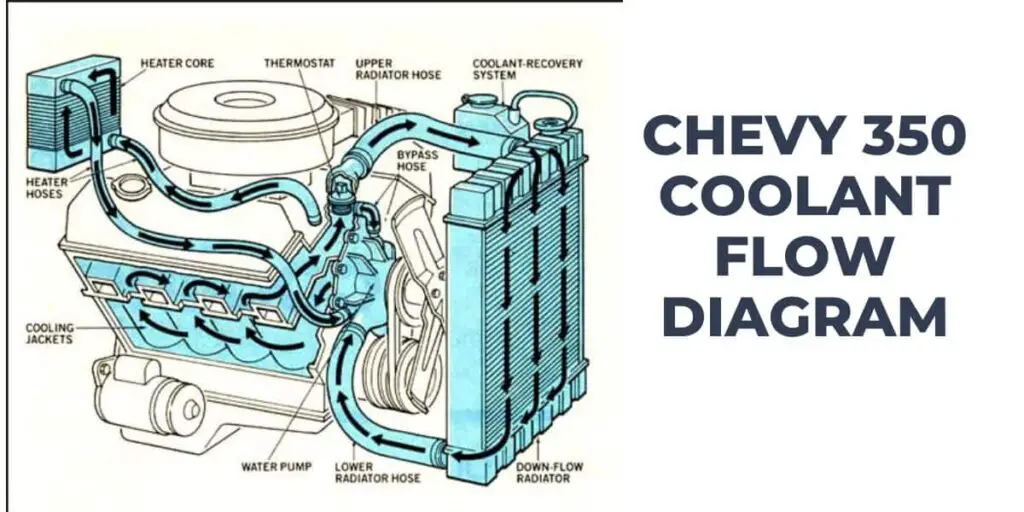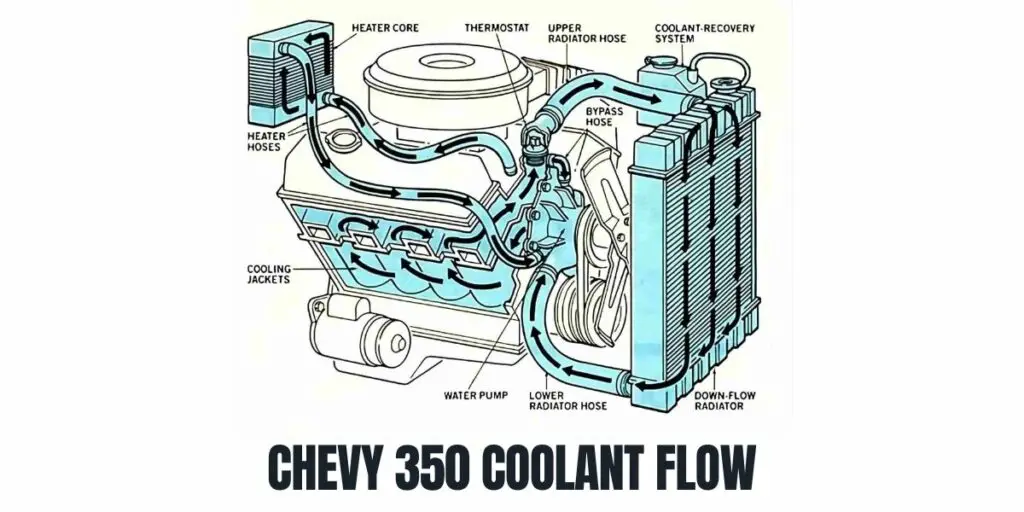If you’re anything like me, you’ve probably spent countless hours tinkering under the hood of your beloved Chevy 350 engine.
Ah, the joy of revving that engine and feeling the power coursing through your veins!
But have you ever wondered how the coolant flows through this mechanical marvel?
Buckle up because today we’re diving deep into the Chevy 350 Coolant Flow Diagram world.
Chevy 350 Coolant Flow Diagram
This is the Chevy 350 Coolant Flow Diagram:

While ensuring proper coolant flow is essential for maintaining optimal engine temperatures in your Chevy 350, if you’re looking to boost its performance on a budget, check out our article on the cheapest sbc supercharger.
Understanding Chevy 350 Coolant Flow Diagram
Understanding the Chevy 350 Coolant Flow Diagram is essential to maintaining the engine’s optimal temperature. It depicts the coolant’s path to regulate the engine temperature effectively. Furthermore, by understanding this diagram, you can identify the key components and their respective roles in the cooling process.
If you’re experiencing Chevy starter engagement problems, don’t worry, I’ve got you covered. Check my post on Chevy Starter Engagement Problems for how to fix them.
Components of the Chevy 350 Cooling System
These are the Components of the Chevy 350 Coolant Flow Diagram:
- Water Pump: The water pump is driven by the engine’s crankshaft and is responsible for circulating the coolant throughout the engine. It draws coolant from the radiator and pushes it into the engine block.
- Engine Block: The coolant enters the engine block through the water pump and flows through passages within the block. These passages surround the cylinders, helping to cool them and prevent overheating.
- Cylinder Heads: The coolant flows from the engine block to the cylinder heads. The cylinder heads have coolant passages that surround the combustion chambers and exhaust ports to regulate their temperatures.
- Thermostat: The coolant then enters the thermostat housing. The thermostat is a temperature-sensitive valve that opens and closes to control the flow of coolant. It stays closed when the engine is cold to allow it to warm up quickly and then opens to allow coolant circulation once the engine reaches operating temperature.
- Radiator: The coolant exits the engine through the thermostat housing and flows into the radiator. The radiator is a heat exchanger that helps dissipate the heat from the coolant. As the coolant passes through the radiator, it cools down with the help of airflow provided by the radiator fan.
- Radiator Cap: The radiator cap serves as a pressure release valve and helps maintain the proper pressure in the cooling system. It also allows coolant to be drawn back into the system as needed.
- Return to Water Pump: After passing through the radiator, the cooled coolant returns to the water pump, where the cycle begins again.
Importance of Maintaining Coolant Flow
Maintaining proper coolant flow is essential for the longevity and performance of the Chevy 350 engine. Insufficient coolant flow can lead to overheating, engine damage, and decreased fuel efficiency.
Regularly checking the coolant level, inspecting components, and performing necessary maintenance can prevent costly repairs and ensure optimal engine performance.
To properly wire the ignition system, it’s crucial to understand the Chevy Ignition Switch Wiring Diagram.
How to Optimize the Coolant Flow in Chevy 350 Engine
Follow the following steps to optimize the coolant flow in your Chevy 350 engine:
- Regularly flush and replace the coolant according to the manufacturer’s recommendations.
- Inspect and replace coolant hoses if they show signs of wear or damage.
- Check for coolant leaks and promptly address any issues.
- Keep the radiator and cooling fan clean from debris and dust.
- Maintain proper tension on the belt driving the water pump.
FAQs on Chevy 350 Coolant Flow Diagram
These are the frequently asked questions about the Chevy 350 Coolant Flow Diagram:
How often should I flush the coolant in my Chevy 350 engine?
It is recommended to flush and replace the coolant every 30,000 to 50,000 miles or as specified in the owner’s manual.
What are the signs of a failing water pump?
Some common signs of a failing water pump include coolant leaks, engine overheating, unusual noise from the pump, and coolant residue around the pump.
Can I use any coolant in my Chevy 350 engine?
It is essential to use the coolant type recommended by the manufacturer to ensure compatibility and optimal performance.
Conclusion
Understanding the coolant flow diagram of the Chevy 350 engine is crucial for maintaining its performance and preventing overheating issues. The components, such as the coolant pump, radiator, thermostat, water jackets, and others, work together to ensure efficient cooling. By optimizing coolant flow and performing regular maintenance, you can keep your Chevy 350 engine running smoothly for years to come.

